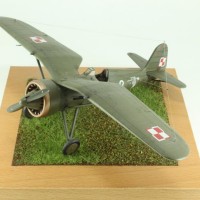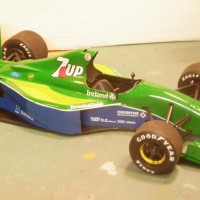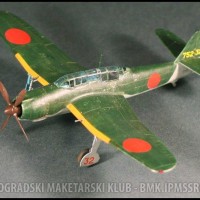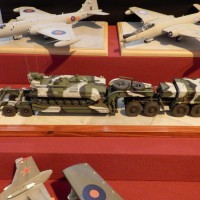Greek Trainer
Acknowledgements
Once again massive thanks to Spiros Pendedekas (@fiveten) and Giannis Asimakos (@mfcg) both of whom were unsparing in their help and assistance in helping me with information to realise this project. Both were more than willing to answer my questions and to help with photos.
History
MS.230s entered Greek service in 1931 as the main basic trainer for the Royal Hellenic Air Force. They performed this role until 1935 when they were replaced by Avro Tutors. However, the MS.230s continued in service as communications and general service aircraft until 1941 and the German invasion. Some were used for reconnaissance with predictably little success.
Model
There's only one kit of the Morane Saulnier 230 - a rather neat little trainer - available. A rather old example by Heller which has been reboxed by Smer and by Sabre Kits in a limited edition with a range of decals. One of the options was M15 of the Royal Hellenic Air Force which makes a nice companion to the Potez 25 I built earlier. The Heller kit is a nice kit with reasonable detail for the time especially the engine (which is good because there aren't any aftermarket Salmson 9Abs available).The Sabre Kits reboxing is flash free and molded in fairly soft plastic. However, the decals are a bit of a disappointment with pixels showing on the roundels and tail flash and numerous errors on the script (for example the 'FRANCE' needs to be in Italic script for the example chosen and the constructor's number is wrong). Still they are workable with but I replaced the roundels and fin flash with hand painted examples.
Assumptions
Like the Potez 25 in Royal Hellenic Air Force service, information is sparse for these aircraft, in fact there is even less available. I was able to find 8 mediocre photos in all covering a total of 7 aircraft with only the most general details on aircraft history. I chose to model M1 - the first Greek MS.230 but found nothing on the aircraft itself. It probably entered service in 1931 but when it left service is not known. So the colour scheme is based mostly on the most well known photos of M15. I also assumed the wheels were spoked - most photos show this with only one (of M4) showing wheel covers. The orientation of the underwing serials was assumed to be the same as well (once again, one photo shows opposite orientation).
The Model
The Heller kit is a nice one but needs modification and improvement to bring it up to current day standards. There are a whole range of LF Models sets available to improve the interior but I avoided these as they looked a bit heavy in scale and scratch built the interior. This wasn't as difficult as it sounds - just painstaking systematic work with plastic strip and rod. Some parts were needed from the spares box but the end result looks very nice. The engine itself also needed work. It represents a French model with rocker covers. On Greek aircraft (and incidentally on a lot of other interwar aircraft with exposed engines) the rocker covers were removed. I cut these off and fabricated the rockers from 0.5 mm rod and 0.3 mm strip for the rocker arms. The pushrods were replaced with 0.28mm builders wire and the inlet and outlet pipes with 0.55 mm builders wire to get the correct profiles. This is essential for the outlet pipes in particular. I also drilled out the exhausts. Heller had omitted the carburetor intake so one of those was added as well.
Spoked wheels came from left over Potez 25 spares and the necessary changes were made to make the kit more like a Greek aircraft. The venturi tube was omitted and the footstep on the left side converted to a one piece. I also modified the elevators which on Greek aircraft were full width and modelled them dropped - a common feature of Greek aircraft on the ground. Colours once again followed Yiannis Tripitsis, FS34096 for the Green and FS15102 for the true blue. Greek MS.230s carried two marking variations. The earliest used black script and carried the construction number (in the A--- range on the tail and in other places). The later variation used counter-shaded script of black and white with the aircraft fuselage number (in the M range) shown. The A--- number was not shown. I chose the earlier variant. A mixture of kit and other decals were used. The small numbers on the undercarriage struts and engine cover came from a Breguet 14 sheet and the aircraft identity on the tail from a Model Decal sheet. Rigging was 0.15 mm brass rod painted dark iron for the support stays and 0.1 mm wire for the rudder control wires. For the tailplane support wires special attention was paid to the photos as the locations differed from other MS.230s . Of course various kit parts were replaced with finer to scale details, particularly the aileron activator rods.
Final thoughts
This is a fun little project. The MS.230 is a very nice little model and stretches one's skills particularly in the area of scratch building. The research is also fun and the end result - a pretty little trainer, fully justifies all the effort.








Nice work! Morane parasols are always interesting to see.
Many thanks John - Heller also do an MS.225 which is also a very nice build.
Well done on a really difficult kit, Christopher (@christopher). The Greek markings are really attractive.
Thanks so much George (@gblair).I do like doing Greek interwar aircraft.
Absolutely stunning, Christopher @christopher
She looks great in Greek markings.
Thanks a lot John. This is a really enjoyable model to build and the markings are among my favourites.
Fantastic result, Christopher! The MS.230 is an esoteric subject, let alone in Greek markings. Your superb research and the resulting model sheds light in less documented Greek plane.
Congratulations!
Many, many thanks Spiros without your invaluable help I wouldn't have been able to get to that stage.
Trainers often make attractive models. The help from your friends, and your meticulous research, has resulted in a fine model.
Hi George. Your comments are really welcome and you're so right. Without the help from Spiros and Giannis the model wouldn't have turned out the way it did.
A great little project, and nice upgrades along the way. Those old Heller kits are usually fun projects for me (finishing up one now...). Well done!
Hi Greg your comments are much appreciated. Which Heller model are you working on?
Great job on that 230! Looks good in Greek livery.
The Greek interwar livery is one of the most attractive I think. Thanks so much for your kind comments Chas.
The modifications are nicely rendered. Good job!
It's very kind of you to say so. Thanks so much John.
Excellent work Christopher @christopher! The extra work put into this build made this old and petit kit look great.
Thanks so much Bob - it's really rewarding when people like my work.